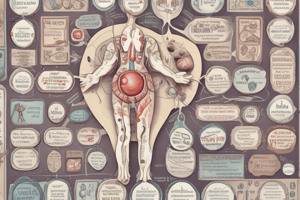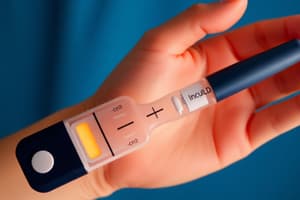Podcast
Questions and Answers
What is the underlying cause of type 1 diabetes?
What is the underlying cause of type 1 diabetes?
- Autoimmune destruction of insulin-secreting beta cells (correct)
- Unknown factors
- Genetic mutation
- Insulin resistance
Type 2 diabetes is commonly associated with insulin resistance.
Type 2 diabetes is commonly associated with insulin resistance.
True (A)
What is the primary defect in metabolic syndrome associated with insulin resistance?
What is the primary defect in metabolic syndrome associated with insulin resistance?
Resistance to the actions of insulin followed by impaired pancreatic beta-cell function
Type 1 diabetes is strongly influenced by __________ factors.
Type 1 diabetes is strongly influenced by __________ factors.
Match the autoimmune disorders with their association with type 1 diabetes:
Match the autoimmune disorders with their association with type 1 diabetes:
What are the common symptoms that patients with type 2 diabetes may present with at diagnosis?
What are the common symptoms that patients with type 2 diabetes may present with at diagnosis?
Marked osmotic symptoms and weight loss are common in patients with type 2 diabetes who present acutely.
Marked osmotic symptoms and weight loss are common in patients with type 2 diabetes who present acutely.
What might patients with worsening hyperglycemia often crave as a result of their condition?
What might patients with worsening hyperglycemia often crave as a result of their condition?
Ketosis and even DKA can occur in patients with type 2 diabetes, especially in the African American population, where up to half of patients have type 2 diabetes instead of type 1 diabetes. This is known as 'Flatbush syndrome' or 'ketosis-prone' ____________.
Ketosis and even DKA can occur in patients with type 2 diabetes, especially in the African American population, where up to half of patients have type 2 diabetes instead of type 1 diabetes. This is known as 'Flatbush syndrome' or 'ketosis-prone' ____________.
Match the following factors with their effects on insulin resistance and deficiency:
Match the following factors with their effects on insulin resistance and deficiency:
Flashcards are hidden until you start studying
Study Notes
Diabetes Mellitus
- Diabetes is a clinical syndrome that develops from the interaction of environmental factors and genetic susceptibility.
- There are two common types of diabetes: type 1 and type 2 diabetes, with distinct underlying genes, environmental factors, and pathophysiology.
Type 1 Diabetes
- Previously known as insulin-dependent diabetes mellitus (IDDM).
- Characterized by insulin deficiency requiring replacement therapy.
- Aetiology and pathogenesis:
- T-cell-mediated autoimmune disease involving destruction of insulin-secreting β cells in the pancreatic islets.
- Presence of autoantibodies to islet and/or β-cell antigens.
- Islet cell antibodies can be present long before clinical presentation and are poorly predictive of disease progression.
- Associated with other autoimmune disorders, including thyroid disease, coeliac disease, Addison's disease, and pernicious anaemia.
- Strongly influenced by genetic factors, with a complex and multifactorial relationship.
- Environmental factors, including viral infections and dietary factors, also play a role.
Clinical Presentation of Type 1 Diabetes
- Patients present when progressive β-cell destruction has crossed a threshold, leading to insulin deficiency and metabolic sequelae.
- Typical presentation includes hyperglycaemia, glycosuria, osmotic diuresis, and dehydration.
- Can manifest at any age, with most cases developing in children and young adults.
Latent Autoimmune Diabetes of Adulthood (LADA)
- Defined as the presence of islet autoantibodies in high titre, without rapid progression to insulin therapy.
- Presents and is managed similarly to type 2 diabetes, but with a more rapid progression to requiring insulin treatment.
Type 2 Diabetes
- Previously known as non-insulin-dependent diabetes mellitus (NIDDM).
- Characterized by insulin resistance and impaired pancreatic β-cell function, leading to 'relative' insulin deficiency.
- Aetiology and pathogenesis:
- Combination of insulin resistance and impaired β-cell function.
- Associated with other medical disorders, including metabolic syndrome, dyslipidaemia, and hypertension.
- Strongly influenced by genetic factors, with multiple genetic defects involved.
- Environmental factors, including physical inactivity, obesity, and overeating, also play a role.
- Age is a significant risk factor, with most cases developing in the middle-aged and elderly.
Clinical Presentation of Type 2 Diabetes
- Often discovered coincidentally, with patients presenting insidiously over months or years.
- May present acutely, with marked osmotic symptoms and weight loss, similar to type 1 diabetes.
- Patients may have a slow onset of 'relative' insulin deficiency, with relatively small amounts of insulin required to suppress lipolysis.
Studying That Suits You
Use AI to generate personalized quizzes and flashcards to suit your learning preferences.




